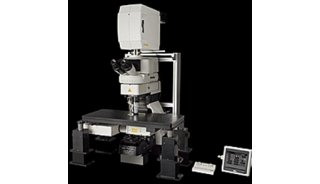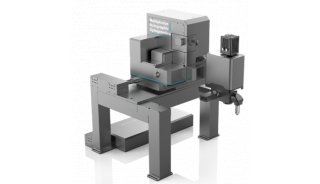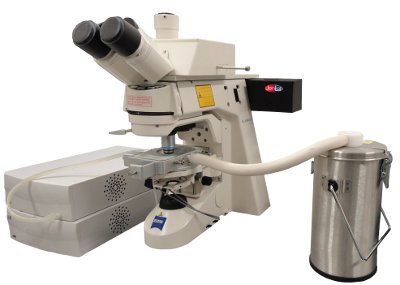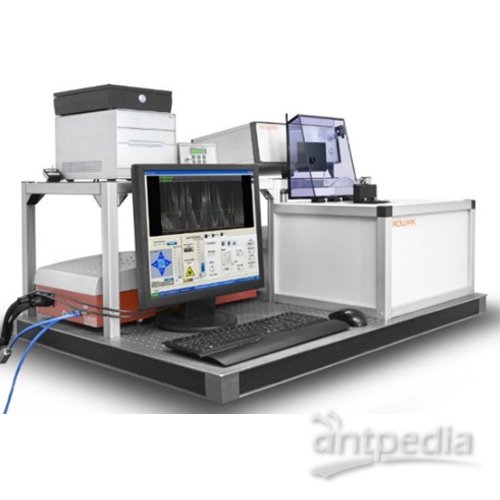LaVision双光子显微镜-多线扫描双光子成像(二)
2. 方法与结果
为了从激光扫描显微镜的功能性成像中得出重要结论,一个高的时间分辨率是很重要的。在低光情况下,这通常通过进行单线扫描来获取。这被以一个垂直系统(VS)神经元的突触前分支的激光共聚焦(Leica SP2)钙离子成像示例 (see Fig. 1, Table 1). 这类神经元对其感受野内的向下运动以其膜电势的逐级去极化的方式响应,这伴随着突触前分支精细末端的钙离子聚集(Kurtz et al., 2001).为达到一个高的时间分辨率(400 Hz),执行了单线扫描。记录中显示,扫描线应该击中了不同直径的两个神经元。模式运动期间钙离子指示染料荧光相对基线荧光的增加表明了细胞溶质自由钙离子浓度的增加。精细神经突中钙离子信号变化更快,不论是刺激动作期间的上升和刺激动作中止后的下降。

Fig. 1. Top: schematic of the fly’s head (caudal view). Vertical System (VS) neurons form an ensemble of 10 cells, belonging to the visual motion-sensitive tangential cells in the fly brain. To study calcium concentration changes in these neurons the lobula plate region was exposed, a single VS2-neuron was impaled with a sharp glass electrode for intracellular recordings and the electrically charged, membrane-impermeant calcium dye Oregon-Green 488 BAPTA-1 was driven into the cell by applying hyperpolarizing current (−1 to −2 nA for 3–5 min). Bottom: single-line scans were performed at the presynaptic region of the VS2-neuron with a Leica SP2 confocal microscope equipped with a long-distance water-immersion 40×/N.A. 0.8 objective (excitation 488 nm, emission 500–560 nm, scan frequency 400 Hz). The arrow below the image of the presynaptic arborizations (left) indicates line position. During downwards motion of a squarewave grating (spatial wavelength: 32◦, temporal frequency: 4 Hz, Michelsen contrast: 99.3%) intracellular free calcium rised, leading to an increase in dye fluorescence (middle). The time course of relative fluorescence changes (_F/F0) is shown averaged over regions containing signal from the upper, thinner neurite (right, black trace) and the lower, thicker neurite, respectively (grey trace). Both the rise of the calcium signal during pattern motion and its decline afterwards appeared faster in the thin neurite. For a more detailed description of animal preparation, electrophysiological procedures and visual stimulation see Kurtz et al. (2001).
在高度分支化的结构,如树突和突触前分支中,对通过单线扫描到的个体神经元间的钙离子动态差异进行系统分析是困难的,因为是否是一个以上感兴趣的区域被扫描线击中是很难控制的。为在一定程度上解决这个问题,我们推出了一种方法,通过多束激光取代单激光束的TPLSM进行钙离子成像。
2.1. 多线TPLSM的原理
来自一个可调谐Ti:Sa激光器(see Table 1)的脉冲化的近红外激光被导向一个基于镜面的光束分光器(Nielsen et al., 2001). 光束分光器的原理是组合了一个位于中央的50%光束分光镜和位于两侧的高反射镜(see Fig. 2). 光束分光器将入射光分为两束,高反射镜将光束重复送回中央的光束分光镜。这个过程产生了高达64束的成一列的激光束阵列。
在我们早期实验中(see also Kalb et al., 2004)使用的光束分光器包含了一个单一光学元件组,每一个元件都被固定在无振动平台上,并可直接调整。在后期实验中(此处所列数据都基于此实验),为了方便,这个用户定制的分光器被用一个新近开发的市场上可以买到的分光器(TriM-Scope, LaVision BioTec, Bielefeld, Germany)所取代。后者配置中所包括的关键组件有衰减器,光束望远镜,色散补偿,光束分光器,和xy扫描振镜,都被装在一个盒子里。
通过扫描器后,激光阵列从背后端口进入倒置显微镜(Olympus IX70)。一直暴露大脑的苍蝇,其一个单独的TC被钙离子敏感染料填充以用于荧光成像,被固定在显微镜载物台上。一个提供视觉刺激的LED板被放在苍蝇视野之内。




















